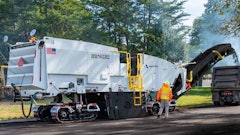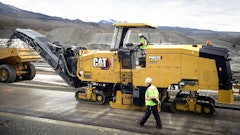
In 2003, an industry came together to find a way to control workers’ exposure to respirable crystalline silica during asphalt pavement milling in highway construction.
The Silica/Asphalt Milling Machine Partnership — which is made up of milling machine manufacturers, the National Asphalt Pavement Association (NAPA), labor, academia, and the National Institute for Occupational Safety and Health (NIOSH) — has worked over the past decade to design, test, and implement engineering controls for milling machines that effectively reduce potential silica exposure below OSHA’s new proposed Permissible Exposure Limit (PEL).
Approximately 367,000 U.S. workers employed in highway, street and bridge construction are at risk of exposure to respirable crystalline silica. Workers use a variety of machines when removing and recycling asphalt pavement, including cold milling machines which feature toothed, rotating cutters that grind and remove pavement for recycling.
During operation workers can inhale silica dust, which can cause silicosis, a debilitating and potentially fatal lung disease. Silica exposure has also been associated with lung cancer, chronic obstructive pulmonary disease (COPD), and renal disease.
“Silicosis is a serious issue,” says Tony Bodway, TITLE with Payne & Dolan headquartered in Waukesha, WI. “As a contractor, it’s a priority that we ensure employees are working in a safe, healthy environment. Exposure to silica dust is something we can prevent on the jobsite, and we should be striving to do that.”
OSHA has an established PEL, which is the maximum amount of crystalline silica to which workers may be exposed during an 8-hour work shift, set at 50 micrograms of respirable crystalline silica per cubic meter of air (50 g/m3). This is consistent with NIOSH’s current Recommended Exposure Level (REL) and will help reduce the risk of developing silicosis, lung cancer, and other adverse health effects.
What manufacturers are doing
Although OSHA has not yet released a final silica PEL, the industry is optimistic that the engineering controls designed between manufacturers and NIOSH will allow workers to forgo the use of respirators during roadway milling operations.
The accumulated efforts of the silica coalition has resulted in new industry cold milling guidelines, also known as the Best Practice Engineering Control Guidelines to Control Worker Exposure to Respirable Crystalline Silica during Asphalt Pavement Milling.
Silica dust controls, such as ventilation controls, used in combination with water-spray controls on asphalt pavement milling machines can consistently reduce exposures below the NIOSH REL and the proposed OSHA PEL.
Below is how each manufacturer has designed its milling machines to help limit operator and crew exposure to silica dust.
Introduced in 2010, the Vacuum Cutting System (VCS) can be found on all of Wirtgen's larger cold mills – the W 250, W 210 and W 200, and the new W 200i and W 210i.
Its principle is simple: by creating a negative pressure in the drum housing, the mix of air and water vapor is evacuated and then fed back into the flow of the milled material transported on the conveyor via a hose system.
“Wirtgen has made the machine operator and his workplace the center of its engineering and development work for many years,” says Brodie Hutchins, vice president of dealer development at Wirtgen America.
Roadtec milling machines have long included a water system with dual spray bars inside the cutter housing, says Kyle Hammon, product manager – Mills, Stabilizers and Brooms at Roadtec.
“The spray bars are positioned at opposite ends of the cutter housing to facilitate both dust control and heat reduction at the cutter drum,” he explains. “The flow rate of the water system is easily adjustable to meet the desired levels of the milling crew.”
The Roadtec RX-600e, RX-700e, and RX-900e models also include a dust extraction system which uses a hydraulic fan to remove dust from the primary conveyor and channel the material to the dump truck alongside the secondary conveyor.
“The dust extraction system is a more recent design change, but the system is included as a standard feature for the safety and comfort of the milling crew,” says Hammon.
BOMAG America
BOMAG is releasing a complete new line of milling machines presently, says John Hood, director of sales, heavy equipment at BOMAG. The BM2000/75 comes into the country fitted with a Dust Suppression System as a standard feature. The smaller BM1200/35 machines have the ability to install the dust suppression kits from the factory or in the field.
“These are quite simply a plenum system that fits into the cutting housing, connect with a powerful suction fan to remove silica and fine dust particulates and blow them thorough a series of hoses or tubes into the bed of the dump truck with the milled asphalt,” says Hood.
Starting in 2016, Caterpillar will offer an optional high-powered vacuum ventilation system.
“This system will use a vacuum fan to extract milling dust from two key areas: the foot of the primary conveyor and the transition point between the primary conveyor and the loading conveyor,” says AJ Lee, global sales consultant with Caterpillar Paving Products.
Cat cold planers also offer an advanced water spray system that provides an ample number of nozzles ideally positioned in the chamber and areas of the conveyors prone to dust. The nozzles are controlled electronically to maintain a precise spray rate that balances water use with optimal dust control.
“Some contractors choose the option of an additional chamber spray bar, but the system is designed to apply exactly the amount of water necessary,” says Lee.
Manufacturers are also required to provide field retrofit kits for sale for older, larger half-lane milling machines.
What you can do
While machine innovations will help limit you and your workers’ exposure to silica dust, there are still more steps you can take to reduce silica dust.
Recognize the hazard. Milling, cutting, or otherwise disturbing asphalt pavement can create airborne dust containing silica. Pay attention to wind direction and any visible dust emissions.
Use ventilation and water-spray controls on asphalt pavement milling machines. Water-spray plus ventilation controls are collectively considered to be the best practice approach to asphalt pavement milling dust control and can reduce exposures below the NIOSH REL.
Typical ventilation controls designed to reduce silica exposures on asphalt pavement milling machines include a collection hood, fan and ductwork. Milling machines should also be designed to allow the operator to temporarily turn the ventilation control off when milling into the wind.
If the ventilation control can be shut off, however, then a feature should be in place to automatically turn the ventilation control back on when it has been off for longer than 60 minutes.
Water-spray controls should always remain ON regardless of wind direction.
Always use water-spray controls on asphalt pavement milling machines that do not have ventilation controls.
When ventilation controls are unavailable, water-spray systems that are properly designed, operated, and maintained can provide a significant reduction in the milling machine’s dust generation.
Other best practice water spray recommendations were developed for contractors that are not using ventilation controls on their asphalt milling machines. The two best methods are:
- Spray water on the pavement being milled to suppress any dust
- Knock down airborne dust by spraying the dust cloud
Many in the industry feel that since a key component of milling machines is the water spray system used for cooling cutter bits on the cutter drum, the same spray system can also be used for silica dust control. To maximize the effectiveness of water spray systems, several alterations may need to be made to optimize the flow, pressure and nozzle locations.
Training required
Finally, the simplest way to be your best advocate is to make sure you and your staff are properly trained.
“The number one best practice is education & training,” says Bodway with Payne & Dolan. “Don’t let your employees get complacent. Not only do they need to understand the hazards of silica dust, but they also need regular training on how to properly operate and maintain the machines they’re working with.”
Equipment manufacturers are great to partner with when it comes to this. Ask them for training on the operation, maintenance and repair of the dust control systems.
“All milling equipment manufacturers offer training when equipment is purchased,” says Bodway. “But take advantage of annual training sessions that are offered as well to keep employees up to speed.”
Milling machine operators should be trained on the control systems and be provided with the operating specifications (water quantity, water pressure, air velocity) that must be maintained in order for the control systems to be effective.
Equipment mechanics responsible for maintaining the water-spray and ventilation control systems on asphalt pavement milling machines may require specialized training.
Operators should also be trained to temporarily disable the ventilation control system when milling directly into the wind.
In addition to using equipment manufacturers, Bodway says there are myriad places to get information. He mentions equipment manuals, NAPA and NIOSH as great sources to stay informed. “If you need to know, ask questions,” he says. “There’s plenty of information and tools out there on this subject. Our top priority is to ensure workers are in an environment that keeps them healthy and safe and allows them to go home at the end of the day.”
For more information
To access the best practices guide, visit goaspha.lt/1JvV4Lv.
The Center for Construction Research and Training and NAPA also released a user-friendly Field Guide for Controlling Silica Dust Exposure on Asphalt Paving Machines. Visit goaspha.lt/1DxPbLr to access the field guide.
















![Screen Shot 2023 01 04 At 5 23 30 Pm[35]](https://img.forconstructionpros.com/files/base/acbm/fcp/image/2023/01/Screen_Shot_2023_01_04_at_5.23.30_PM_35_.63bc42696de27.png?auto=format%2Ccompress&fit=crop&h=135&q=70&w=240)


![Bm 2200 65 Cold Planer Release[17]](https://img.forconstructionpros.com/files/base/acbm/fcp/image/2023/06/BM_2200_65_Cold_Planer_release_17_.649359d81b660.png?auto=format%2Ccompress&fit=crop&h=135&q=70&w=240)




